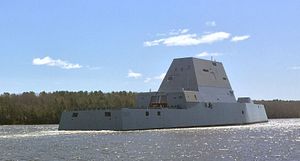Yesterday, the U.S. Navy’s next generation guided-missile destroyer USS Zumwalt departed the General Dynamics Bath Iron Works shipyard in Maine to conduct acceptance trials in the Atlantic Ocean with the Navy’s Board of Inspection and Survey, an organization created to inspect U.S. naval warships and to report on their readiness, according to an April 20 press release.
“While underway, many of the ship’s key systems and technologies including navigation, propulsion readiness, auxiliary systems, habitability, fire protection, and damage control capabilities will be demonstrated to ensure they meet the Navy’s requirements,” the press release notes. Once the trials are completed, the guided-missile destroyer will be transferred to San Diego, where the majority of the Zumwalt’s combat systems will be installed.
Previously, the ship successfully completed builder’s trials in March 2016 and December 2015 in the Atlantic Ocean. The March 2016 tests specifically focused on the ship’s Advanced Induction Motor and the so-called Integrated Propulsion System. The tests this month will also involve rough-weather trials to assess the seaworthiness of the ship.
As I explained previously (See: “US Navy’s Lethal New Destroyer Heads for Sea Trials”):
Naval experts have repeatedly raised concerns over the ship’s so-called tumblehome hull and how it will impact the ship’s ability to stay afloat during bad weather periods.
Nevertheless, the U.S. Navy continues to defend the design feature, noting that the “tumblehome ship design has provided a wide array of advancements.”
This wave-piercing tumblehome hull was specifically designed to reduce the ship’s signature. In fact, AP reported earlier in the month that the USS Zumwalt is using reflective material that can be hoisted to make it more visible to other vessels. The future guided-missile destroyer is purportedly 50 times harder to detect than current U.S. Navy destroyers.
All in all, the U.S. Navy plans to induct three Zumwalt-class guided-missile destroyers. All three ships will be home-ported in San Diego, U.S. Defense Secretary Ashton Carter revealed this month. Once in service, the Zumwalt-class vessels will be one of the U.S. Navy’s most powerful weapons platforms and capable of hitting targets far inland.
“Each ship features a battery of two Advanced Gun Systems (AGS) firing Long-Range Land Attack Projectiles (LRLAP) that reach up to 63 nautical miles [72 miles, 115 kilometers], providing a three-fold range improvement in naval surface fires coverage,” according to the U.S. Navy website.
The Zumwalt-class will be one of the U.S. Navy’s most expensive weapons programs in its history with total procurement costs for the first-in-class Zumwalt nearing $4 billion and cost estimates for the two subsequent vessels at around $2.8 billion and $2.4 billion respectively. The USS Zumwalt is scheduled to achieve initial operational capability in October 2016.
































